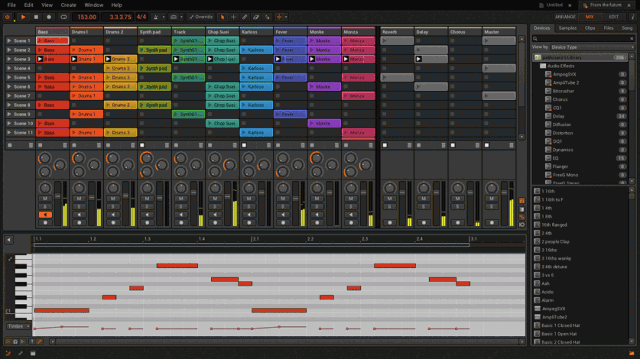For years, since the launch of Ableton Live, many have waited for a worthy rival, something that combines production and live performance for music users. Live isn’t without alternatives – Renoise, for instance, has earned some fans, though it isn’t necessarily built for live performance. But few provide the same real-time workflows.
Bitwig, based in Berlin as is Ableton and featuring some Abletronic veterans, today took the wraps off its own Bitwig Studio. The good news is, it’s looking as though it might shape up to be a viable tool for DJing, performing, and making music. The bad news is, in a market already crowded with lots of similar tools vying for your attention, the first release will look more familiar than radical. That is, it looks and works a whole lot like Live. There’s an Arranger view, a clip launching view with scenes, a tray on the bottom with effects and instruments (they’re even called Devices, like in Live). The screen layout, and even specific interface widgets and channel strip arrangements are all straight out of Live.
It’s not just a little like Ableton Live, either – it’s in some cases a direct clone. Nested drum machine Devices, for instance, work in a way that I’ve never seen out of Ableton Live. A channel strip similarity or two is almost inevitable; here, though, lots of little details add up to something that feels like Ableton, but didn’t come from Ableton.
What that means to you may depend on what you want: whether you just want an improved Ableton alternative that works like Live, or whether you want something more fundamentally different from Live as an alternative.
If you want “Ableton Plus,” Bitwig does take on features Ableton is missing. For instance:
1. Linux support. In fact, right out of the gate, this could quickly be the answer for Linux users waiting for something they could use without booting to Mac or Windows.
2. Proper multiple document support. You can share content between projects in Ableton, but here you can actually open and freely exchange media with multiple files at once.
3. Mix audio and MIDI on the same track. Tracks are content-agnostic.
4. Per-note automation, with the mixed MIDI and audio, promises more detail-oriented editing.
Those are three significant breakthroughs. And it looks like there are lots of tweaks and improvements throughout the tool, many of which I’m sure we’ll hear about as people begin testing the beta. (One nice example: a vertical pane lets you view arrange and clip launching views simultaneously.) Multi-monitor support, while present in many tools, is sorely lacking in Live but available here. Plus, as some readers note, you do get 64-bit support, though that seems an advantage over Ableton that won’t last long.
The challenge is, as a new entrant to the market, your first obstacle is telling a story about what you are. And here, there seems a missed opportunity to make a first impression as something truly different, rather than something “similar, but better.” Ableton Live 1.0 when it was released was a significant departure from what had been seen before. So, too, were the first trackers, the first audio+MIDI DAWs, and the first graphical sequencers. Bitwig Studio isn’t that kind of breakthrough – not yet.
Not that being different is easy, or even always desirable. Amidst so many things users want, and so many expectations they have about how things will work, it’s tough to do something genuinely new without simply confusing everyone and driving them away. But it has happened – Ableton Live’s original release being a notable case. One question is whether you make some sacrifices to release the most significantly-different tools initially, or whether you choose to cover the basic bases to provide a workable solution from day one, and the Bitwig devs seem to have chosen the latter.
The most interesting features remain on the horizon. LAN multi-user jamming and multi-user production are both on the roadmap – features we’ve seen in other tools, but which have yet to catch on. And there’s an integrated modular system that lets you build your own instruments and effects with graphical patching – something seen in various forms from Buzz to Max for Live, but one that could use a fresh take in integration with the tool.
In the meantime, we’ll have to hear from beta users whether Bitwig is something worth a look. You can sign up now:
http://bitwig.com/bitwig_studio.php
We’ll be eager to hear what you think.


